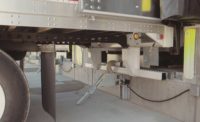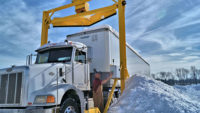Advancements in technology and automation have changed virtually every aspect of our daily lives. From programmable thermostats to keyless auto ignitions to smart phones, digital innovations have helped increase efficiency and are just plain cool. But this technological revolution extends well beyond the consumer world.
Cutting-edge robotics, AS/RS systems, AGVs and warehouse management systems have taken industrial facilities into the 21st century. Yet, despite these new tools, many loading dock operations still use manual labor and are stuck using 20th century technologies and practices. But even that is changing. Interlocked, integrated loading dock control systems are prime examples of this loading dock modernization.
Loading dock control systems
Traditionally, the various pieces of loading dock equipment – including vehicle restraints, levelers and overhead doors – were operated independently of each other. They all began as manual operations, such as the setting of wheel chocks on a trailer’s rear tires once positioned at the loading dock. These tasks were not only time-intensive (requiring employees to go outside and set the equipment), they were potentially dangerous. And whenever there is a chance for human error, there is a chance for a wide range of potential accidents. At the loading dock, those accidents can lead to serious injury or death.
Today’s leading loading dock control systems do away with the danger associated with human error by automating the process – beginning with the vehicle restraint. Restraints that automatically secure a trailer or vehicle when it backs up to the dock increase efficiency and safety by eliminating the need for dock employees to go outside and physically secure the trailer. They also eliminate the opportunity for mistake, ensuring the trailer can’t mistakenly pull away when a forklift is still inside.
Automatic restraints can work by locking onto the trailer’s wheels or – more commonly – its rear impact guard (RIG). The most advanced RIG-based automatic vehicle restraints offer a RIG/restraint vertical engagement range of 9 to 30 inches. Some models can even help secure intermodal overseas container chassis, which are increasingly common across the supply chain due to the re-opening of the Panama Canal. Additionally, some automatic restraints can be integrated into building management systems and security systems, providing another level of security and protection against external tampering.
At-a-glance light communication
Engagement of the restraint triggers a dock safety communications system. The traditional signaling system is a familiar fixture at plants and warehouses, with green and red lights indicating the status of the vehicle restraint. Inside, a green light tells the forklift operator the trailer is secured and safe to enter. Outside, the light turns to red, letting the truck driver know that it is not safe to pull away from the dock, as the trailer might still be getting serviced. The lights are reversed when the restraint gets unlocked, telling the truck driver he can depart safely.
More advanced light communications systems go several steps further. Due to obstructions in their view of the control box, it is easy for forklift operators to overlook the vehicle restraint status when they are entering or exiting the trailer. For example, stacks of pallets in the staging area can block the view of status warning lights on an eye-level control box. Control box status lights might also get visually lost among several other control boxes or signs on the dock wall. And, of course, control boxes can’t be seen from inside the trailer.
In each case, the forklift driver becomes unknowingly at risk if the restraint becomes inadvertently unlocked. Advanced light communications systems provide visual cues for the forklift driver on a sight-line above the control box, at the corners of the door opening, as well as on the dock lever providing visual verification while they are in the trailer. These advanced systems provide another level of security that allows forklift drivers to proceed into and out of trailers with confidence, which boosts productivity.
Safe sequence of operations
The newest dock controls go well beyond light communications, however. When integrated into these systems, the vehicle restraint’s engagement triggers the ability for dockworkers to use other equipment in a safe sequence of operations. For instance, these systems can be programmed into a single device with a green light interlock, which disables the use of the hydraulic leveler or overhead door until the vehicle restraint is safely engaged; an overhead door interlock, which requires overhead doors to be opened prior to leveler operation; or a stored leveler interlock, which ensures that the leveler is stored safely before the restraint can release the trailer. This type of control panel takes out the human error part of the equation when it comes to operating equipment at the loading dock door.
These advanced control systems use a modern user interface with updated membrane switch buttons. NEMA 4X rated, these control systems are also built to withstand the harsh conditions on a loading dock to meet requirements for electrical noise, electrical and environmental conditions, and chemicals. In addition, they have flexible circuitry and can be modified to update components or add features well after original installation.
Barriers positioned near the edge of the dock door to prevent falls out of the dock opening can also be integrated into this safe sequence of operation. Once the trailer is securely in place, the lock button is pressed to engage the restraint, the light on the control box turns green and the barrier releases for easy access to the trailer. The most advanced barriers – made from PVC-coated fiberglass mesh and heavy-duty polyester – can stretch across openings 16’ 5” wide and are able to stop up to 30,000 lbs. with minimal damage to the barrier.
Automating safety at the loading dock
Loading docks and warehouses are quickly catching up to internal manufacturing operations in terms of “automating-in” safety and efficiency. Automatic vehicle restraints that are capable of handling RIG-obstructed container chassis and interlocked loading dock control systems are quickly bringing the loading dock into the 21st century. While many of these systems are relatively new, expect to see them become ubiquitous in coming years.
The information in this article is provided as a general reference regarding the use of the applicable product(s) in specific applications. This information is provided without warranty. It is your responsibility to ensure that you are using all mentioned products properly in your specific application and in accordance with all laws and regulations.


